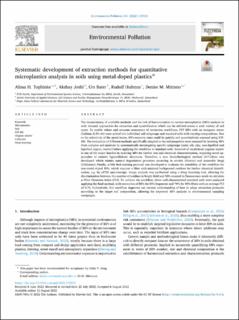Bitte benutzen Sie diese Kennung, um auf die Ressource zu verweisen:
https://doi.org/10.21256/zhaw-25749| Publikationstyp: | Beitrag in wissenschaftlicher Zeitschrift |
| Art der Begutachtung: | Peer review (Publikation) |
| Titel: | Systematic development of extraction methods for quantitative microplastics analysis in soils using metal-doped plastics |
| Autor/-in: | Tophinke, Alissa H. Joshi, Akshay Baier, Urs Hufenus, Rudolf Mitrano, Denise M. |
| et. al: | No |
| DOI: | 10.1016/j.envpol.2022.119933 10.21256/zhaw-25749 |
| Erschienen in: | Environmental Pollution |
| Band(Heft): | 311 |
| Heft: | 119933 |
| Erscheinungsdatum: | 2022 |
| Verlag / Hrsg. Institution: | Elsevier |
| ISSN: | 0269-7491 1873-6424 |
| Sprache: | Englisch |
| Schlagwörter: | Microplastics; Deep learning; Soil; ICP-MS; CAZymes; Organic matter |
| Fachgebiet (DDC): | 006: Spezielle Computerverfahren 333.7: Landflächen, Naturerholungsgebiete |
| Zusammenfassung: | The inconsistency of available methods and the lack of harmonization in current microplastics (MPs) analysis in soils demand approaches for extraction and quantification which can be utilized across a wide variety of soil types. To enable robust and accurate assessment of extraction workflows, PET MPs with an inorganic tracer (Indium, 0.2% wt) were spiked into individual soil subgroups and standard soils with varying compositions. Due to the selectivity of the metal tracer, MPs recovery rates could be quickly and quantitatively assessed using ICP-MS. The evaluation of different methods specifically adapted to the soil properties were assessed by isolating MPs from complex soil matrices by systematically investigating specific subgroups (sand, silt, clay, non-lignified and lignified organic matter) before applying the workflow to standard soils. Removal of recalcitrant organic matter is one of the major hurdles in isolating MPs for further size and chemical characterization, requiring novel approaches to remove lignocellulosic structures. Therefore, a new biotechnological method (3-F-Ultra) was developed which mimics natural degradation processes occurring in aerobic (Fenton) and anaerobic fungi (CAZymes). Finally, a Nile Red staining protocol was developed to evaluate the suitability of the workflow for non-metal-doped MPs, which requires a filter with minimal background residues for further chemical identification, e.g. by μFTIR spectroscopy. Image analysis was performed using a Deep Learning tool, allowing for discrimination between the number of residues in bright-field and MPs counted in fluorescence mode to calculate a Filter Clearness Index (FCI). To validate the workflow, three well-characterized standard soils were analyzed applying the final method, with recoveries of 88% for MPs fragments and 74% for MPs fibers with an average FCI of 0.75. Collectively, this workflow improves our current understanding of how to adapt extraction protocols according to the target soil composition, allowing for improved MPs analysis in environmental sampling campaigns. |
| URI: | https://digitalcollection.zhaw.ch/handle/11475/25749 |
| Volltext Version: | Publizierte Version |
| Lizenz (gemäss Verlagsvertrag): | CC BY 4.0: Namensnennung 4.0 International |
| Departement: | Life Sciences und Facility Management |
| Organisationseinheit: | Institut für Chemie und Biotechnologie (ICBT) |
| Enthalten in den Sammlungen: | Publikationen Life Sciences und Facility Management |
Dateien zu dieser Ressource:
| Datei | Beschreibung | Größe | Format | |
|---|---|---|---|---|
| 2022_Tophinke_etal_Systematic-development-extraction-methods-quantitative-microplastics.pdf | 1.9 MB | Adobe PDF |  Öffnen/Anzeigen |
Zur Langanzeige
Tophinke, A. H., Joshi, A., Baier, U., Hufenus, R., & Mitrano, D. M. (2022). Systematic development of extraction methods for quantitative microplastics analysis in soils using metal-doped plastics. Environmental Pollution, 311(119933). https://doi.org/10.1016/j.envpol.2022.119933
Tophinke, A.H. et al. (2022) ‘Systematic development of extraction methods for quantitative microplastics analysis in soils using metal-doped plastics’, Environmental Pollution, 311(119933). Available at: https://doi.org/10.1016/j.envpol.2022.119933.
A. H. Tophinke, A. Joshi, U. Baier, R. Hufenus, and D. M. Mitrano, “Systematic development of extraction methods for quantitative microplastics analysis in soils using metal-doped plastics,” Environmental Pollution, vol. 311, no. 119933, 2022, doi: 10.1016/j.envpol.2022.119933.
TOPHINKE, Alissa H., Akshay JOSHI, Urs BAIER, Rudolf HUFENUS und Denise M. MITRANO, 2022. Systematic development of extraction methods for quantitative microplastics analysis in soils using metal-doped plastics. Environmental Pollution. 2022. Bd. 311, Nr. 119933. DOI 10.1016/j.envpol.2022.119933
Tophinke, Alissa H., Akshay Joshi, Urs Baier, Rudolf Hufenus, and Denise M. Mitrano. 2022. “Systematic Development of Extraction Methods for Quantitative Microplastics Analysis in Soils Using Metal-Doped Plastics.” Environmental Pollution 311 (119933). https://doi.org/10.1016/j.envpol.2022.119933.
Tophinke, Alissa H., et al. “Systematic Development of Extraction Methods for Quantitative Microplastics Analysis in Soils Using Metal-Doped Plastics.” Environmental Pollution, vol. 311, no. 119933, 2022, https://doi.org/10.1016/j.envpol.2022.119933.
Alle Ressourcen in diesem Repository sind urheberrechtlich geschützt, soweit nicht anderweitig angezeigt.